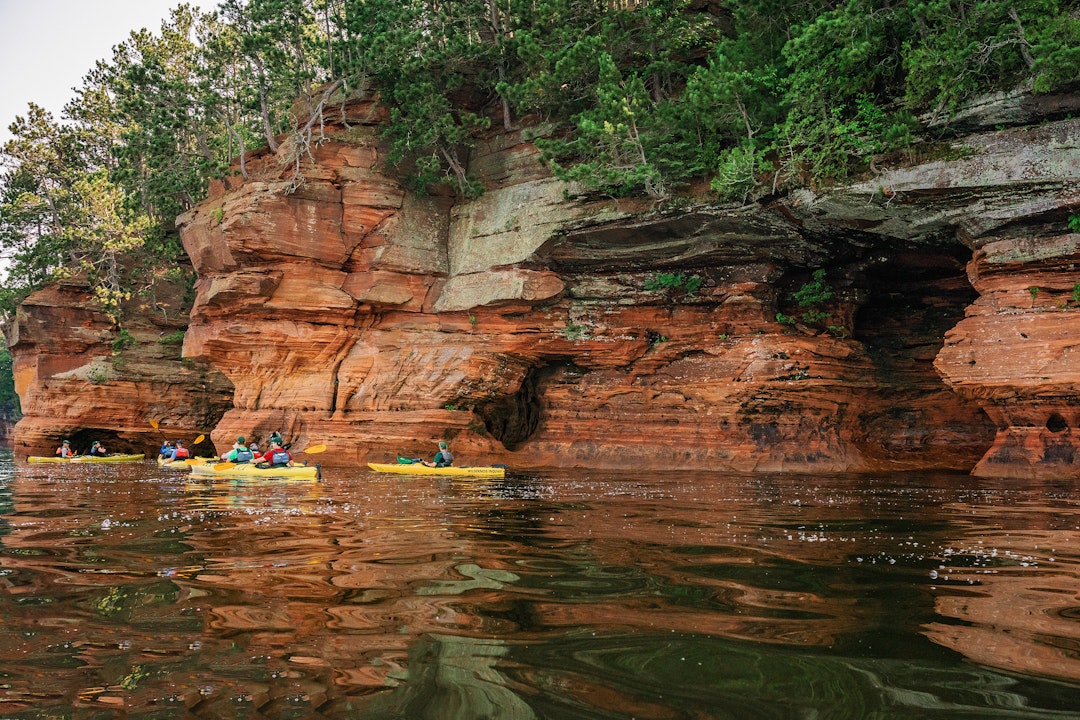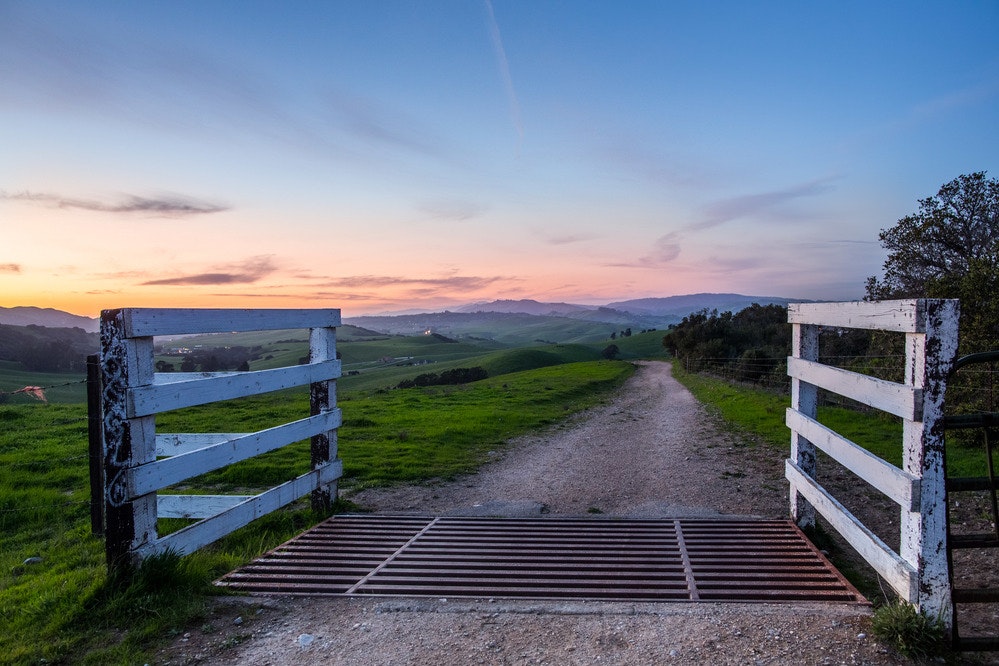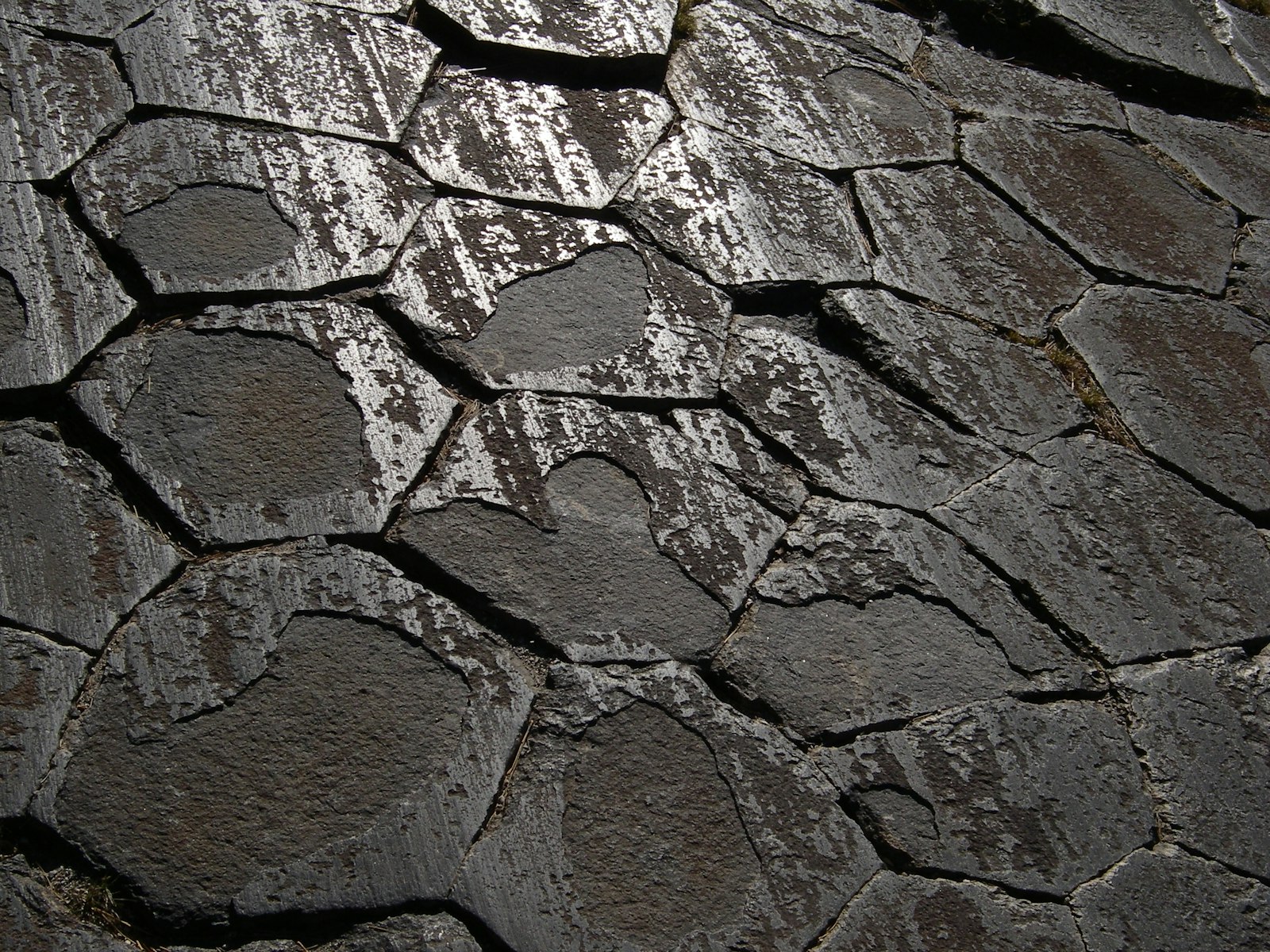
Making the Isolated, Accessible

.
.
“When I’m looking to go to a national park, I would ask friends, is there something off the beaten path that you suggest, that you experienced, and you think I could benefit from seeing it?” says Michael Halder. “And the second question is, is it accessible?”

For Halder, a lifelong lover of the outdoors and experienced canoer, a trip to Apostle Islands National Lakeshore takes a bit more planning. Halder has cerebral palsy. You’re likely to see Halder traversing the steep steps down to the lakeshore with some help and then navigating the lakeshore with his walker.
“I feel I’m very fortunate that I can get out in the wilderness,” says Halder. “I love the outdoors.”

He’s made adaptations to his walker to continue getting outdoors– more than doubling the size of his front wheels to help navigate park rocks and roots.
Even with the modifications, the rugged nature of Apostle Islands National Lakeshore doesn’t make it easy. The park is made up of 21 islands with 12 miles of mainland shoreline, spread out over 270 square miles on the waters of Lake Superior. With container ships and barges making regular crossings, the lake itself feels more like an ocean.
Halder first found his love for the wilderness in highschool when he would make the trek nearly 100+ miles further north from Apostle Islands National Lakeshore to the boundary waters, a collection of lakes and waterways along the U.S.-Canada border.
Even as his friends moved away or became busier with families and work and the trips to the boundary waters became fewer and far between, Halder still felt the call to the outdoors. But with the increasing physical limitations due to his cerebral palsy, Halder needed a partner.
Adaptive Excursions
He found that partner in Wilderness Inquiry, a nonprofit committed to making the outdoors accessible to all through guided group excursions.
Ever since that first call to Wilderness Inquiry, Halder has been a regular face on their canoeing and kayaking trips.


“Wilderness Inquiry promotes individuals getting out in nature,” says Halder. “And over the years, I’ve seen it where they’ve developed or made adaptations to get individuals that are challenged to be able to go on a canoe trip or go kayaking in Lake Superior.”
Wilderness Inquiry’s adaptive equipment includes a universal paddling seat that provides extra torso and head support, hand and wrist attachments that supplement paddle grips for people who have limited strength in their hands, and adjustable bolsters to customize watercraft seating so that people with back conditions or little lower body control can comfortably sit in a canoe or kayak.

Along with the technical components, Wilderness Inquiry also staffs their trips with trained guides and volunteers who personally assist each individual on the trip.
"For more than 30 years, Wilderness Inquiry has run kayak trips and outdoor recreation opportunities in the Apostle Islands for hundreds of people annually who come from across the country to explore with us,” says Erika Rivers, Wilderness Inquiry’s executive director. “Opening the beauty and popularity of the national lakeshore to everyone, including our many participants who experience and live with a disability, is core to our work in the area and our mission of helping all people experience the best of the Apostle Islands.”
Halder was participating in a Wilderness Inquiry day trip to Apostle Islands National Lakeshore alongside about 20 other participants, including Sam Fischer and his father Paul Fischer.

Sam says he enjoyed the day because he’s always liked being outdoors. “I feel calm when I’m in the outdoors, especially here.”
“What’s so unique to me about Wilderness Inquiry is there’s lots of organizations that will say, sure, we’ll figure it out if you have some type of limiting disability. Wilderness Inquiry seeks out those people and says, we’re going to put groups together and foster the bonds that are created. It’s that level of intentionality to me that distinguishes them,” says Paul.
That intentionality and assistance is paramount, agrees Halder. “Just being able to get into the park and be able to navigate by myself from the parking lot down to the water, it’s a challenge,” he says.
And that’s all before he reaches the steep incline of the stairs on Meyers Beach in the park, where he and the Wilderness Inquiry crew were launching kayaks from in July 2024.
Friends of Apostle Islands

To help make the beach more accessible, the park is installing a new ramp connecting the Meyers Beach parking lot with the sand, allowing people to walk on a gradual grade to the beach, sliding their kayaks on the side railing.
The National Park Foundation, in partnership with L.L.Bean, and the Friends of Apostle Islands National Lakeshore, is helping fund the new ramp. The National Park Service also contributed a portion of the funding through the Centennial Challenge Program, which provides matching funds for donor-supported signature projects and programs.

The Friends of the Apostle Islands National Lakeshore has been integral to the accessibility efforts in the park since 2012. While NPF and NPS supports all national park sites, the Friends of Apostle Islands is dedicated entirely to supporting Apostle Islands National Lakeshore, with accessibility as one of their main philanthropic priorities.
“Accessibility is one of the four key pillars of Friends - along with education, service, and stewardship,” Jeff Rennicke, executive director of Friends of the Apostle Islands National Lakeshore, says, “But it all begins with getting people safely to these special places that they will fall in love with and want to give back to. Access is the key to it all.”
In partnership with NPS, the Friends of the Apostle Islands National Lakeshore has helped fund a wheelchair accessible overlook on the dock at Little Sand Bay; accessible campsites, restrooms, and more than a mile of boardwalk on Sand Island; an accessible amphitheater and campsite on Stockton Island; and audio and tactile interpretative materials at visitor centers and online.
Today, Friends of Apostle Islands’ Access for All campaign is helping raise funds alongside NPF’s efforts for the Meyers beach ramp.
“Access for All is by far the largest capital campaign in our organization’s history,” Rennicke says, “and has been a true grassroots effort with over 500 donors and sponsors ranging from a few dollars to major supporters like L.L.Bean and the National Park Foundation. That range of support speaks volumes about how important this work is and its value to all of us.”
A Visionary for Accessibility
Lynne Dominy, superintendent at Apostle Islands National Lakeshore, came to the Wisconsin park in 2019 knowing that the park team was already talking about how to make the park more accessible. Since taking the helm, she has taken that conversation and turned it into a park priority. Instead of addressing piecemeal projects – a ramp here, an audio experience there, Dominy has created a holistic accessibility plan to make the remote 70,000 acres of land and 270 square miles of water more accessible.

“One of the ways I think about accessibility is that accessibility is an investment in everyone’s future,” says Dominy. “Ramps, boardwalks, and handrails help everyone have a barrier free experience.”
These are adaptations the vast majority of park visitors need at one point or another– whether you have a bad knee and are on crutches, are pushing a baby stroller and need an even surface, or you could benefit from adaptive displays as your hearing or vision worsens with age.
“It’s about mobility, it’s about hearing, it’s about vision, it’s about mental challenges. It’s about changing abilities in our lives for all people and keeping parks accessible for all,” she says.

And for Dominy, accessibility isn’t just a concept. In 2012, she was in a serious car accident when she was hit head on by someone talking on a cellphone. MedEvac’ed to a hospital, she broke both of her legs and her left arm. Dominy spent the next three years learning how to walk again, how to balance, and how to use things differently than before. She adapted.
“It was a learning experience about what it feels like to be in an environment where you’re constantly running into barriers, where you can’t get into a parking spot or into a building, where you can’t get into a bathroom, where you can’t reach something on a store shelf, where you can’t come down a staircase to get to a beach,” Dominy says. “So I learned a very quick lesson about the importance of removing barriers from every environment, personally. I was very committed to accessibility, and I still am.”


A Culture of Accessibility
Dominy’s plan is predicated on what she calls, “a culture of accessibility.”
That culture “is about removing barriers and not adding more barriers for anyone that’s trying to come into this environment,” she says.

Those barriers include staircase and doorways, she says. Instead of thinking of the beach as a difficult place to access, her team thinks about adding mats so that it’s easier for people with mobility concerns to walk through the sand.
Navigating the sand is especially important at Meyers Beach, one of the launch points to the top attraction at the park: the mainland sea caves.
“There are a lot of people that only come here for the day and they see photographs of these amazing mazes of sandstone caves and they really want to go try kayaking,” says Dominy. “And so the problem we have here is a staircase and people have to carry very heavy equipment up and down the staircase. And if you have any kind of mobility, balance, or vision issues, stairs can be an extreme barrier to having experiences on beaches and sea kayaking in a place like this.”
While the ramp is one of the next big solutions, the park’s accessibility plan goes beyond physical infrastructure to seamlessly integrate adaptations across the park for a universal experience.
“I don’t think most people think when they’re looking at the most accessible landscape that they’re going to go to an island, and we’re trying to change that and make it where you expect that, that it is accessible,” says Dominy.
Dominy and team are doing just that on Sand Island. The island is one of the closest to the mainland, just over two miles northwest from the Little Sand Bay boat launch, and is home to one of the most photographed sites in the park– the Sand Island Lighthouse.
Being so close to the mainland, Sand Island is the perfect spot for visitors just making a day trip to the park or who may only be able to kayak a shorter distance. Visitors with accessibility concerns can either go with a guided group like Wilderness Inquiry or use the accessible boat ramps on both the mainland and Sand Island.
Once they’re on the island, the accessibility features are so seamlessly folded into the landscape, you hardly notice they’re there.
The island includes accessible picnic tables with space for a wheelchair to use them, campgrounds on raised platforms, and wheelchair accessible bathrooms.
And instead of traditional dirt trails to navigate the island’s wet interior, Dominy’s team created a “maze of boardwalks” that take you to the campsites, bathrooms, and hidden historic sites – all of which are accessible to a visitor in a wheelchair.
The boardwalks are wide enough for a wheelchair and bypass the roots and rocks that give someone like Halder with a walker trouble. On a metal frame with the legs sitting just on the surface of the ground, the boardwalk isn’t dug into the ground, nor does it use any concrete. It sits high enough off the ground to protect the wetlands underneath– allowing the natural ecosystem to thrive relatively untouched while visitors still walk through the island.
When complete, the boardwalk will wind its way through the island for two miles - taking visitors all the way to the Sand island Lighthouse.

“You don’t often think about lighthouses being easily accessed because most of them are on a cliff. Most of them are up giant staircases. Most of them are off big, rocky shorelines. So they’re not very easy to get to. But we are building a backdoor to the Sand Island lighthouse on the boardwalk. And so when we get to the end of the boardwalk, not only will we have protected the wetlands that the trail goes through, but we will also have provided access to one of the nine lighthouses in Apostle Islands,” Dominy says.
“And then we’ll be able to say that you truly can, no matter what your abilities are, get to one of the lighthouses on Sand Island in Apostle Islands National Lakeshore.”
THANKS TO OUR PARTNERS
This accessibility project at Apostle Islands National Lakeshore was made possible in part by generous funding from L.L.Bean.
Our Work
-
 Area of workParks of the Future
Area of workParks of the Future -


There’s Always Room for More Support
Let’s translate rising interest in our national parks into increased support for them. By supporting the National Park Foundation, you’re fueling innovative solutions that will shape the future experience and health of our parks.